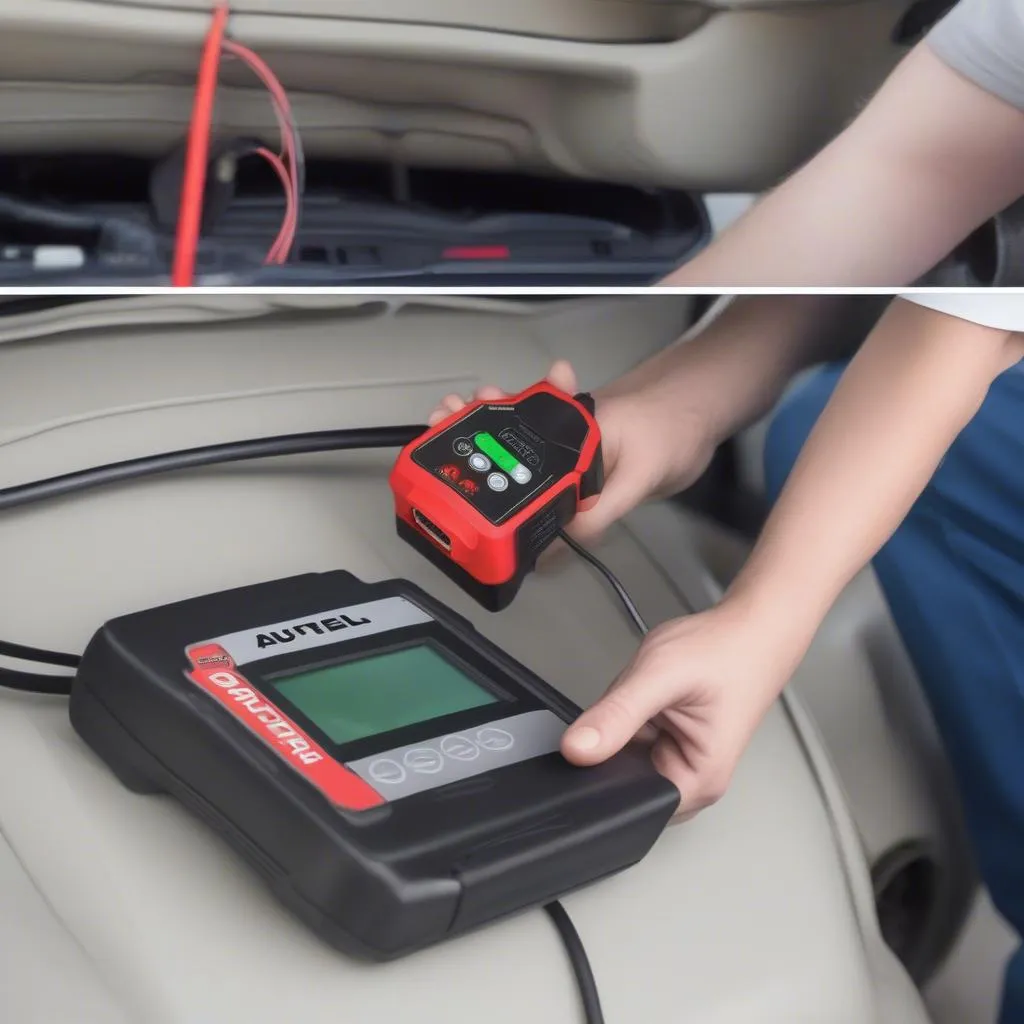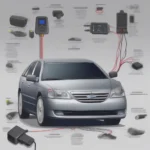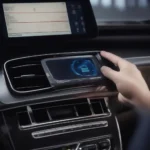Autel OBD2 EOBD scanners are powerful tools that can help you diagnose and fix car problems. Whether you’re a seasoned mechanic or a car enthusiast, knowing how to use an Autel scanner can save you time and money. This comprehensive guide will walk you through the process step-by-step, empowering you to take control of your vehicle’s health.
Understanding Your Autel OBD2 Scanner
Before diving into the how-to, it’s essential to understand the basics. OBD2 stands for On-Board Diagnostics, a standardized system that allows your car’s computer to communicate with external devices like scanners. Autel, a leading name in diagnostic tools, offers a range of OBD2 scanners with varying capabilities. EOBD, or European On-Board Diagnostics, refers to the European standard, which is very similar to OBD2. Most Autel scanners are compatible with both.
Locating the OBD2 Port in Your Vehicle
The OBD2 port is usually located under the dashboard on the driver’s side. It’s a 16-pin trapezoidal connector. If you’re having trouble finding it, consult your vehicle’s owner’s manual.
Connecting the Autel Scanner and Turning on the Ignition
- Connect the Autel scanner to the OBD2 port. Ensure a secure connection.
- Turn the ignition ON but do not start the engine. This powers up the scanner and allows it to communicate with your car’s computer.
Navigating the Autel Scanner Menu
Once connected, the Autel scanner will power on. You’ll typically be greeted with a menu screen. Common options include:
- Read Codes: This function retrieves diagnostic trouble codes (DTCs) stored in your vehicle’s computer, indicating potential problems.
- Erase Codes: After addressing the issues causing the codes, you can use this function to erase them from the system.
- Live Data: View real-time data from various sensors in your vehicle, such as engine RPM, coolant temperature, and oxygen sensor readings.
- Special Functions: Depending on the Autel scanner model, you may have access to advanced features like ABS bleeding, airbag system reset, and more.
Reading and Interpreting Diagnostic Trouble Codes (DTCs)
- Select the “Read Codes” option from the main menu. The scanner will communicate with your car’s computer and display any stored DTCs.
- Each DTC consists of a five-digit alphanumeric code. The first character indicates the system where the fault lies, while the remaining characters provide more specific information about the problem.
- Refer to a reliable source, such as the Autel user manual, an online DTC database, or OBDFree’s comprehensive resources, to understand the meaning of each code.
Clearing Diagnostic Trouble Codes
Caution: Only clear codes after you have identified and addressed the underlying problem. Clearing codes without fixing the issue is like silencing a fire alarm without putting out the fire.
- After resolving the issue, connect the scanner and navigate to “Erase Codes.”
- Confirm the erase command. The scanner will communicate with your car’s computer to clear the stored codes.
Utilizing Live Data for Advanced Diagnostics
Live data provides a wealth of information about your vehicle’s performance in real time.
- Select “Live Data” from the Autel scanner’s menu.
- Browse through the available parameters, such as engine RPM, coolant temperature, and oxygen sensor readings.
- Monitoring live data can help you pinpoint issues that may not trigger a DTC but can still affect your vehicle’s performance.
Exploring Special Functions (Model Dependent)
Advanced Autel scanners may offer special functions like ABS bleeding, which involves activating the ABS system to flush out air bubbles, or resetting service lights. Refer to your specific Autel scanner’s user manual to explore and utilize these features safely and effectively.
Tips for Using Your Autel Scanner Effectively
- Keep your scanner updated. Autel frequently releases software updates that add new features, improve compatibility, and fix bugs.
- Invest in a high-quality Autel scanner. While budget-friendly options exist, investing in a more advanced model will provide you with more features and capabilities.
- Consult reputable resources. If you’re unsure about a DTC or how to proceed, don’t hesitate to consult reputable online resources or automotive professionals.
Conclusion
Mastering the use of an Autel OBD2 EOBD scanner is an invaluable skill for any car owner or enthusiast. By following the steps outlined in this guide, you can unlock the power of this tool to diagnose, troubleshoot, and maintain your vehicle with confidence. For more in-depth information and reviews on specific Autel scanner models, be sure to check out our comprehensive resources at autel ms309 universal obd2 scanner engine fault reader and autel ap200 bluetooth obd2 scanner car code reader reviews.


